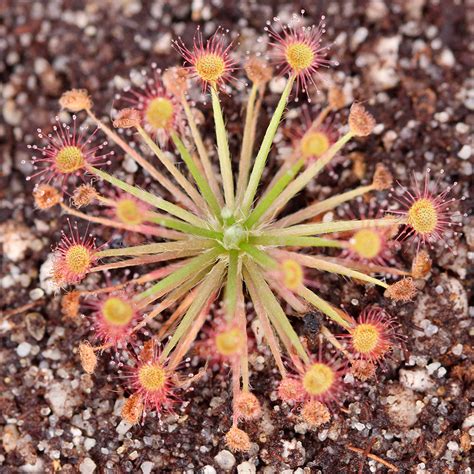

Drosera paradoxa
General
Drosera paradoxa is a fascinating species of carnivorous plant native to northern Australia. Known for its unique appearance and adaptive strategies, it’s a member of the sundew family (Droseraceae) and is particularly famous for its versatility in responding to seasonally changing environments. Sundews in general use sticky glandular leaves to catch and digest insects, but this species stands out for its ability to form a woody trunk over time, which is rather unusual among Drosera.
Physical Characteristics
This sundew displays a rosette of narrow, elongated leaves radiating from a central trunk—often becoming a striking, upright column as the plant matures. The leaves are covered with sparkling, sticky mucilage that captures prey. Each leaf is often tinged red to green, depending on growing conditions and light exposure. Over time, older leaves die back, revealing a hardened, blackish “stem” that can reach over 30 cm (12 inches) tall in mature specimens. During the blooming season, it sends up inflorescences bearing small, white or pink flowers.
Lifestyle
D. paradoxa is a perennial, living for many years when conditions are stable. It is a master of adaptation—growing during the wet season and surviving the dry spell by shedding its leaves and relying on its woody stem. It supplements poor soil nutrients by trapping and digesting small insects, using enzymes secreted by the mucilage-covered tentacles on its leaves.
Habitat and Protection
This species is native to the seasonally flooded floodplains, creek edges, and sandstone outcrops of Australia’s Northern Territory and the Kimberley region of Western Australia. It thrives in humid environments with periodic flooding during the rainy season. While not yet considered threatened, habitat destruction due to mining, agriculture, or fire remains a potential concern. Maintaining its natural water regimes is crucial for its continued well-being in the wild.
Cultivation
Gardeners and collectors are drawn to its unusual growth and manageable care needs. It’s best suited for experienced carnivorous plant growers, especially those ready to provide distinct wet and dry seasons. Seeds generally germinate easily under proper conditions, and the plant tolerates pot culture well if moisture and temperature requirements are respected.
Special Features
The defining trait of this sundew is its ability to form and maintain a woody trunk, which allows it to survive and regrow rapidly following fire or drought, a rare adaptation among sundews. Its vivid dew-tipped leaves, quick responsiveness to prey, and spectacular shifts between leafy and dormant forms make it a true stand-out in any collection.
Care
Light
Bright, filtered sunlight is ideal, with several hours of morning or late-afternoon direct sun enhancing color and vigor. If growing indoors, supplement with strong grow lights (at least 12-16 hours per day).
Temperature
This species enjoys warm to hot temperatures during the active growing season—ideally between 25°C and 35°C (77°F to 95°F). It tolerates nighttime drops into the low 20s°C (mid-60s°F). Avoid prolonged exposure to cold below 10°C (50°F).
Water
During the active growing/wet season, provide constant moisture by standing the pot in 2–3 cm (1 inch) of distilled, rain, or RO water. In the “dry” season, allow the soil surface to dry out slightly but never completely; reduce watering and avoid letting the plant sit in water for extended periods.
Soil
A fast-draining, nutrient-poor mix is essential. Try a 1:1 blend of washed sand and sphagnum peat moss, optionally adding perlite for extra drainage. Avoid any fertilizers or rich composts.
Nutrition
It gets most of its nutrients by digesting small insects. Supplement with occasional live prey (tiny flies or gnats) if grown indoors, but do not fertilize with chemical products.
Humidity
High humidity (60%–90%) during active growth is beneficial. In the dry season, this species is tolerant of moderate humidity drops but should not be subjected to extremely arid conditions for long.
Dormancy
This plant undergoes a natural dormancy in response to dry conditions. Leaves may turn brown and fall away, leaving only the woody stem. Reduce watering but never allow complete dehydration. When new growth appears—signaling the return of the wet season—resume regular watering.
Common Problems
Poor growth or leaf drop
Cause: Insufficient light, low humidity, or inadequate watering during active growth.
Solution: Increase light exposure, maintain higher humidity, and adjust watering frequency (especially mimicking wet/dry seasonal changes).
Sticky traps losing function
Cause: Water with minerals, chemicals, or overly dry air.
Solution: Use only pure water (rain, distilled, or reverse osmosis) and raise humidity.
No dew on leaves
Cause: Air too dry, plant stressed, or water is impure.
Solution: Increase humidity and double-check water purity.
Brown stem tips or sudden wilt
Cause: Prolonged drought or extreme dryness during dormancy.
Solution: Water sparingly but do not let the soil completely dry out, even when dormant.
Poor flowering or seed set
Cause: Insufficient light or plant not fully mature.
Solution: Improve lighting and give the plant time—it flowers most reliably after 2–3 years.
